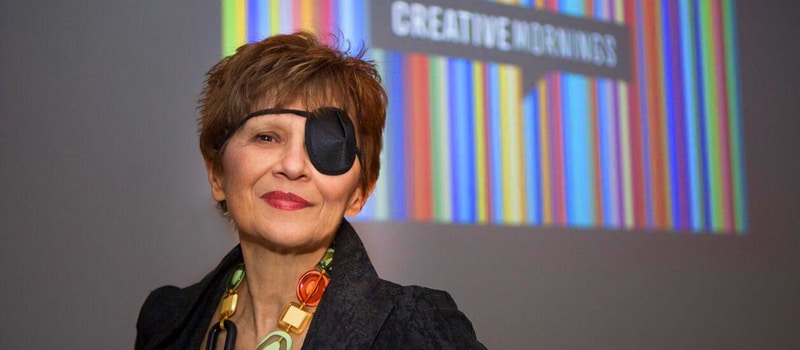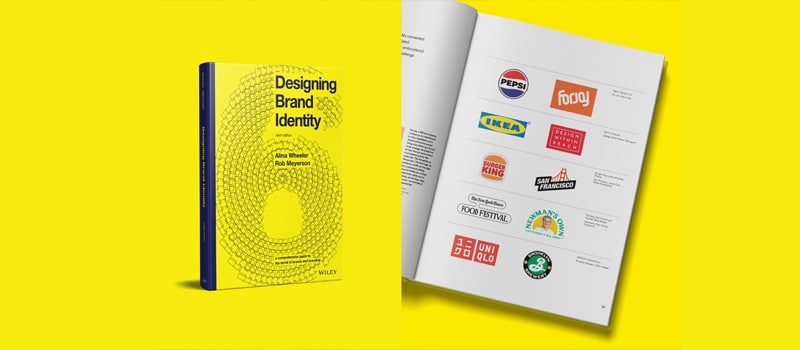In this article I am joined by with Rob Meyerson and Robin Goffman about Designing Brand Identity with structure & processes
Now Rob & Robin were heavily involved in the 6th edition of Alina Wheeler's classic book, Designing Brand Identity, which has become a staple for brand identity designers and their processes since 2002.
And in our chat we dive into
Why Structure & Processes Are So Important In Designing Brand Identities
How To Learn From Case Studies Of Successful Brands
Designing Touch Points On The Brand Experience Across Different Media
So, if you want to refine and improve your processes for designing effective brand identities, with lessons from one of the most influential books in the field… then don’t miss this article.
Insights into Working with an Industry Legend. (Alina Wheeler)

Stephen
Unfortunately, Alina has passed quite recently. So, you know, I was obviously devastated to hear that you guys working so closely with her, you know, she is a legend in the industry with the influence she's had.
Can you just tell me a little bit about Alina? Unfortunately, I didn't get to meet her, but I do believe that she was a joy to work with.
Tell me a little bit about your experience working with her?

Robin Goffman
Alina Wheeler was not only a pioneering female founder of Katz Wheeler, one of Philadelphia's top design firms in the eighties and nineties, but also an active member of numerous industry associations, including African Design Matter.
Her contributions were recognized with a beautiful tribute in December, which I highly recommend everyone to check out.
Beyond her professional achievements, Alina was a dedicated mentor, teaching and speaking at universities, agencies, and organizations of all sizes.
She had an incredible ability to connect with people from all over the world, and I was fortunate enough to be one of the many she mentored, starting from my sophomore year in college.
Even now, over a decade later, I still regard that time as a peak moment in my career.
Alina was a true creative genius, and those who knew her can attest to her kindness and generosity.
I learned a great deal from her and shared many laughs, making my time with her truly memorable.
Rob Meyerson
Reflecting on the experience of partnering with Alina Wheeler on her groundbreaking book, "Designing Brand Identity," which emerged as a seminal work in the field 20 years ago, it's clear her brilliance and creativity were as expected.
However, working closely with her revealed unexpected and delightful aspects of her personality. Alina's kindness and down-to-earth nature were the icing on the cake during the collaboration process.
Her sense of humor not only permeated our interactions but also subtly made its way into the book, rewarding readers who pay close attention.
Moments like taking breaks for M&Ms or discussing her fondness for ice cream added a layer of warmth and humanity to our work sessions.
These instances weren't just mere breaks but pivotal points that allowed us to bounce ideas around in a dynamic and energizing way, much like a pinball machine of creativity and problem-solving.
Despite the seemingly chaotic process, Alina's unmatched energy and fun-loving spirit were instrumental in accomplishing a significant amount of work, both for the book and throughout her illustrious career.
PRO Brand Strategy BluePrint
Build Brands Like A Pro Brand Strategist

The Structure of Designing Brand Identity

Stephen
Reflecting on the profound influence Alina Wheeler had on many individuals beyond her iconic book, it's clear that working on such a revered piece of literature would have been a privilege and perhaps a bit daunting, given its 20-year legacy.
One aspect of the book that stands out is its structure, which is something I greatly appreciate in the context of brand strategy.
Rob, could you share what inspired the structured approach in "Designing Brand Identity"?

Robin Goffman
Alina Wheeler's creation of "Designing Brand Identity" was driven by the absence of such a resource in the market. Her extensive career and experiences shaped not only the content but also the structured approach of the book, which is divided into three main sections: basics, process, and best practices.
The first section, "Basics," lays the foundation by establishing a shared vocabulary among all stakeholders, from clients to creative leaders.
The second section, "Process," delves into the intricacies of the branding process, from initial research to managing assets, providing clarity on why the process is comprehensive and time-consuming.
The final section, "Best Practices," showcases over 50 new case studies from around the globe, a first for the book.
One standout example is the Chobani case study, admired for its unique and colorful brand identity, which has influenced trends in typography and wordmarks.
These case studies offer real-world examples that cover not just the creative solutions but also the goals, strategies, and results of each project, providing valuable insights into the practical application of brand identity principles.
How To Educate Clients and Staff

Stephen
Case studies in the new edition of "Designing Brand Identity" are a fantastic resource for solidifying learning.
They bring theory and practice together, providing a comprehensive view of the branding process.
This addition is particularly valuable in addressing the education gap in the market regarding branding. As someone with a design background, I understand that this gap exists not only in design but also significantly in strategy.
Educating clients and staff is crucial, as informed clients value the work more. How do you recommend readers utilize this book to bridge the knowledge gap and educate their clients or staff effectively?

Rob Meyerson
Highlighting the educational purpose behind Alina Wheeler's creation of "Designing Brand Identity," it's evident that one of her primary goals was to demystify the world of brand terminology and process for her clients.
This intention extends beyond a singular audience; the book serves as a vital resource for students in undergraduate and graduate courses, seasoned practitioners, and clients alike.
Described as an "encyclopedia of brand," it's not designed for a linear read but rather as a reference that readers can consult for concise, digestible insights into specific topics.
With references to leading thinkers like David Ocker and Mark Riddleson, it encourages further exploration into the subject matter. Moreover, the structured format of the book makes it an excellent foundation for academic coursework, offering a comprehensive guide through the intricacies of branding from concept to execution.
This multifaceted approach not only bridges the knowledge gap but also enhances the value clients and practitioners alike find in branding efforts.
The Importance of Strategy in Brand Design

Stephen
The book "Designing Brand Identity" primarily stems from the visual aspects of branding, yet I've noticed a significant gap in information regarding strategy and its influence on design.
As a designer, decisions are often made based on a certain rationale. Before encountering this book, much of my work was guided by intuition or current trends.
Could you shed some light on the importance of strategic thinking in the brand design process and how it integrates into the overall workflow?

Robin Goffman
The essence of design work extends beyond mere aesthetics or following trends; it necessitates a foundation built on strategic thinking. This approach to strategy isn't about adhering to a universally accepted method.
Often, strategic thinking might be happening even unconsciously, guided by an understanding gained through research on the client, the business, market landscape, competitors, and crucially, the customers or potential audience.
The goal is to grasp what resonates with them and how a design can facilitate a business in achieving its objectives.
This is how design transcends its superficial layer to become a problem-solving tool, contributing to a business's success while also being aesthetically appealing.
Strategy involves amalgamating various insights and distilling them into coherent ideas that can be visualized not only in the form of design but through diverse business tactics.
For instance, considering the customer experience within a retail environment from the first thing they see to their interaction with staff and other customers illustrates strategic thinking that goes well beyond graphic design or logos.
It underscores the comprehensive role strategy plays in branding, reminding us that a brand's identity is far more than just its visual symbols.
Explore Brand Strategy
Programs & Tools
Common Pitfalls in Messaging and Voice

Stephen
Having transitioned from a design background to the world of strategy, I've come to appreciate the integral role that logos and visuals play when harmoniously paired with strategic thinking.
It's a delicate balance between the two, akin to the yin and yang, where each element amplifies the importance of the other.
In branding, we communicate both visually and verbally, with messaging serving as a crucial intersection between strategy and design. Rob, your passion for the power of words and language in branding has been evident in our previous conversations, and it has inspired me to delve deeper into this aspect.
Could you shed some light on some common pitfalls brands encounter in their messaging and voice, and how they can navigate these challenges effectively?

Rob Meyerson
In the realm of branding, verbal identity plays a crucial role alongside its counterpart, visual identity. While many might associate verbal identity primarily with naming, it encompasses much more, including messaging and voice.
In the latest edition of "Designing Brand Identity," we've updated a section to specifically address messaging and voice, highlighting their significance in the industry.
Messaging pertains to what a brand communicates, whereas voice is the manner in which it's conveyed.
These elements should complement each other, though they can be considered separately.
Common pitfalls in messaging include redundancy, where brands echo the same sentiments as their competitors, and a lack of focus, particularly noticeable in B2B sectors where brands attempt to cover too broad a spectrum.
As for voice, brands often fall into the trap of sounding too generic or, conversely, trying too hard to be trendy, resulting in a loss of authenticity.
The key is to find a balance that resonates with the target audience while maintaining the brand's unique identity.
Our book provides numerous examples of successful brand messaging and voice, along with practical tips for avoiding these common pitfalls.
The Significance of Brand Ideals

Stephen
Case studies are indeed a powerful tool for learning about branding, offering insights into the successes and pitfalls of different brands.
A common mistake I've observed in messaging is the excessive focus on the brand itself, emphasizing "who we are" and "what we do," rather than addressing the audience's needs and concerns.
This approach can alienate the very people brands aim to connect with.
Instead, messaging should highlight how the brand understands and can address the audience's challenges, fostering a deeper connection.
In "Designing Brand Identity," the concepts of brand ideals, particularly flexibility and coherence, are emphasized.
Could you provide more detail on the importance of these ideals in shaping a brand's identity and how they contribute to a brand's overall messaging strategy?

Robin Goffman
In the book "Designing Brand Identity," coherence and flexibility are highlighted as two of the nine key ideals that underpin a successful brand strategy.
Positioned consecutively, these ideals may seem contradictory at first glance, with coherence emphasizing consistency and alignment across all brand elements, while flexibility allows for adaptability and innovation.
However, the most effective brands master the delicate balance between these two concepts.
Coherence ensures that every aspect of the brand, from its messaging to its visual presentation, is harmonious and reinforces a familiar identity.
On the other hand, flexibility enables a brand to evolve and respond to new opportunities or challenges, ensuring its relevance and preventing stagnation.
Together, coherence and flexibility create a dynamic brand identity that remains steadfast yet responsive, allowing for sustained recognition and growth over time.
How To Create Touchpoints Across Different Media

Stephen
Touchpoints are a fascinating aspect of branding that I'm particularly enthusiastic about. They serve as the front lines of the brand experience, directly shaping the brand's reputation and image in the market.
Everything from the initial interaction to the lasting impression is interconnected and contributes to the overall perception of the brand.
Given their significance, I'm curious about your approach to creating touch points across various media.
How do you ensure consistency and impact in every encounter a customer has with the brand, regardless of the medium?

Robin Goffman
Transitioning from the discussion on coherence and flexibility, it's clear how integral these concepts are in crafting touchpoints across various media.
"Designing Brand Identity" showcases over 800 examples of touchpoints, with 75% being new additions.
This revelation prompts a revision of the commonly cited statistic that a modern brand has over a hundred touchpoints; now, it's more accurate to say there are over 800 examples documented in the book.
However, it's crucial to clarify that this figure does not represent 800 distinct types of touchpoints but rather individual instances, encompassing everything from logos to various items that can carry a brand's visual identity.
Among these, ephemera like T-shirts, beer koozies, and keychains illustrate the tangible aspects of brand identity that can be experienced in everyday life.
Alina Wheeler's original list has been updated to include even more examples of how brands can manifest physically in the world.
This extensive collection serves not just as inspiration but as a testament to the balance between maintaining a consistent brand voice and adapting flexibly to new opportunities.
From Chobani's distinctive enamel pins to Modelo's innovative augmented reality activations, the book demonstrates the myriad ways in which brands can engage with their audience, ensuring that the brand remains a dynamic force across all touchpoints.
The Challenge of Renaming a Brand

Stephen
In the realm of branding, approaching touchpoints as individual projects can significantly enhance the overall brand experience.
By focusing on creating something unique for each touchpoint, designers and strategists can ensure that the brand's identity is not just about visual representation but about crafting memorable experiences at every interaction.
This holistic view encourages a deep dive into the essence of the brand, beyond the surface level, to maintain consistency while fostering innovation.
Shifting focus to the topic of renaming a brand, which is a nuanced and complex challenge, I'm curious about your perspective, Rob.
Renaming can involve various considerations, such as the brand's heritage, existing market image, and reputation.
How do you recommend brands navigate the process of renaming, especially when balancing the need to retain recognizable elements with the desire for a fresh identity?
What strategies or approaches do you find most effective in ensuring a successful transition while honoring the brand's legacy and current standing in the market?

Rob Meyerson
Returning to the comfort zone of naming strategies, it's intriguing to note the absence of a specific chapter on renaming in my book on brand naming a gap I plan to address in any future editions.
However, "Designing Brand Identity" does tackle this complex subject, drawing on the wisdom of Philip Durbrow and Ken Pasternak of Marshall Strategy.
Their insights form the basis of ten core principles for renaming, emphasizing the importance of assessing the impact of a name change, avoiding trendy choices to ensure longevity, and the critical legal considerations of ownership.
The transition process is also a significant factor; if a name change is decided upon, executing a smooth transition while effectively communicating the reasons behind it is paramount.
The overarching advice is to avoid renaming unless absolutely necessary.
This stance is supported by an article I penned, advocating for maintaining a brand's name to preserve its identity unless faced with insurmountable issues like legal challenges or market expansion hurdles that render the original name unusable.
Further analysis in the brand names report reveals a preference for shorter names during a change, suggesting that brevity often leads to stronger acceptance.
Yet, the success of a new name isn't just about the name itself but also the legacy and sentiments attached to the old one. The reaction to a new name can significantly depend on the public's connection with the previous name.
For instance, the renaming of Alitalia to ITA Airways faced criticism not necessarily due to the new name's qualities but because of the deep history and affection associated with the original, highlighting the complexities and emotional ties involved in the renaming process.
On-Demand Digital Program
Brand Master Secrets
Make the transition from hired-gun to highly valued brand strategist in less than 30 days. The systems, frameworks and tools inside this comprehensive program are all you need to level up.












